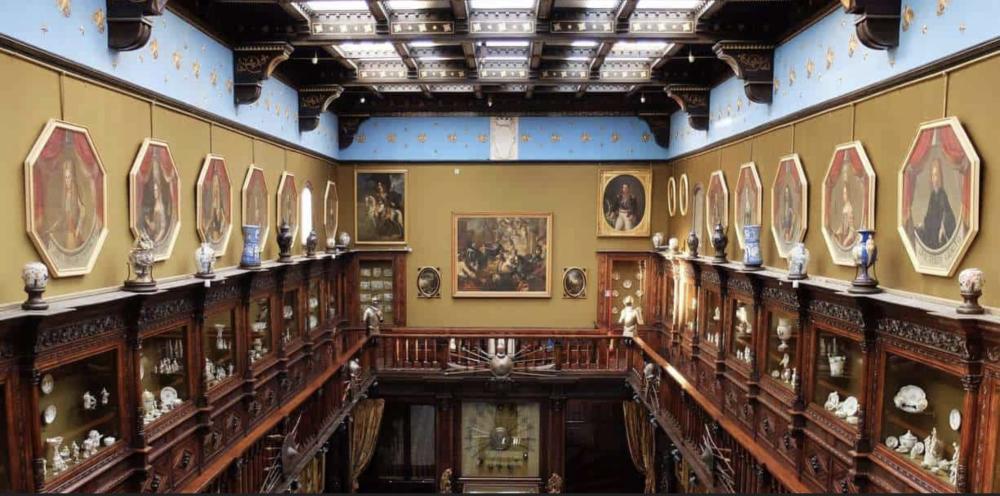Il Museo Civico Gaetano Filangieri fu fondato nel 1882 da Gaetano Filangieri Principe di Satriano, figlio del generale Carlo e nipote dell′omonimo filosofo autore de La Scienza della Legislazione. Luogo di produzione e luogo di esposizione e dei modelli, fabbrica e museo si completano a vicenda e si uniscono idealmente in un articolato progetto culturale per la ex capitale del Regno delle Due Sicilie. Il Museo ha sede nel quattrocentesco Palazzo Como, rara testimonianza a Napoli dell′architettura rinascimentale che lo rende vicino stilisticamente ai fiorentini palazzi Strozzi e Medici; popolarmente noto in passato come il Palazzo che cammina poiché, per consentire la rettifica dell′attuale via Duomo, l′antica facciata nel 1880 fu spostata di circa venti metri. Fu proprio durante la costruzione di Via Duomo che Filangieri, membro della Commissione municipale per la conservazione dei monumenti, propose di donare al Comune le sue collezioni e di allocarle nel traslocato Palazzo Como e completamente a sue spese progettare e realizzare gli interni per adattarli a sede espositiva. Nella personalissima ricostruzione, che guarda ai dettami sul restauro in stile proposti in Francia da Viollet-le-Duc, Filangieri scelse di raccordare il calore di un palazzo-museo con i fini conoscitivi e comparativi di un museo moderno. Il risultato è un originale e unico spazio espositivo che unisce alle citazioni del passato (si pensi alla scala elicoidale, alle vetrate, agli intagli e ai ferri battuti da lui stesso disegnati in stile neorinascimentale) soluzioni museografiche funzionali e all′avanguardia come la copertura a lucernaio della sala Agata che garantisce un′illuminazione diffusa dall′alto o il ricorso all′ampio ballatoio che, oltre ad offrire un ulteriore spazio espositivo, consente al visitatore uno sguardo d assieme molto suggestivo. Contenitore e contenuto dialogano perfettamente e ancora oggi il Museo non ha perso quel fascino e quel calore da dimora patrizia che costituisce già di per sé una testimonianza storica estremamente interessante, pur avendo subito nel corso degli anni perdite e spoliazioni.
The Gaetano Filangieri Civic Museum was founded in 1882 by Gaetano Filangieri Prince of Satriano, son of General Carlo and grandson of the homonymous philosopher, author of The Science of Legislation. Place of production and place of exhibition and models, factory and museum complement each other and ideally come together in an articulated cultural project for the former capital of the Kingdom of the Two Sicilies. The Museum is housed in the fifteenth-century Palazzo Como, a rare testimony in Naples of Renaissance architecture which makes it stylistically close to the Florentine Strozzi and Medici palaces; popularly known in the past as the walking palace because, to allow the rectification of the current via Duomo, the ancient facade in 1880 was moved about twenty meters. It was during the construction of Via Duomo that Filangieri, a member of the Municipal Commission for the conservation of monuments, proposed to donate his collections to the Municipality and to allocate them in the relocated Palazzo Como and completely at his own expense to design and build the interiors to adapt them to headquarters. exhibition. In the very personal reconstruction, which looks at the dictates on style restoration proposed in France by Viollet-le-Duc, Filangieri chose to link the warmth of a palace-museum with the cognitive and comparative purposes of a modern museum. The result is an original and unique exhibition space that combines references from the past (think of the helical staircase, the stained glass windows, the carvings and the wrought ironwork he himself designed in the Neo-Renaissance style). skylight of the Agata room which guarantees diffused lighting from above or the use of the large gallery which, in addition to offering an additional exhibition space, allows the visitor a very suggestive overall look. Container and content interact perfectly and even today the Museum has not lost that charm and warmth of a patrician residence which in itself constitutes an extremely interesting historical testimony, despite having suffered losses and looting over the years.













